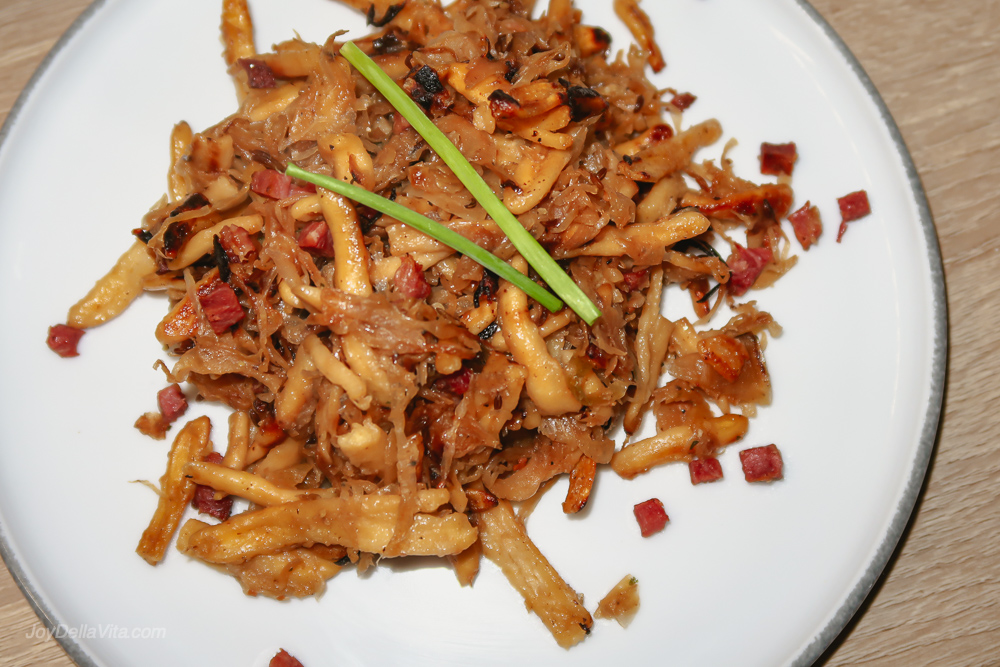The perfect comfort food – Krautschupfnudeln. It is almost impossible to go to a Christmas market in Germany and not have at least one booth selling this delicious dish. However, this recipe is for Krautspätzle, a preparation which is quite similar to the German Christmas market Krautschupfnudeln. Spätzle is a traditional pasta which is made with fresh eggs. Whereas Schupfnudeln is prepared with potatoes and is thicker. They are rather a dumpling than a noodle and heavier and filling. I like the version with Spätzle more as it gives you more room for Sauerkraut on your plate (and frying pan!) and the relation of carbs to kraut is just better in my opinion, with Spätzle. So, here my version of German Krautspaetzle with bacon ham, served with some fresh chives.
Krautspätzle may be a staple at markets in the period before Christmas, but you can of course also enjoy them endlessly all winter. Especially in the weeks after the new year when it’s still chilly outside. You might also be interested in other German recipes.
What you will need for a portion of German Krautspätzle, similar to Krautschupfnudeln
Spätzle – they are one of the two main characters of this dish, Spätzle. Originally from the area of Swabia in southern Germany, they are egg noodles. Usually prepared by “cutting” thing pieces of fresh dough right into boiling water. Simmer them for a short period and serve them immediately. Nowadays you usually buy them dry and cook them fully at home. Of course, you can also prepare them from scratch yourself, or buy them “fresh”. Sometimes you won’t even need to cook, just reheat, them before serving and enjoying them.
Sauerkraut – the other super important ingredient of this hearty winter dish. Sauerkraut can also be bought pre-made, canned, or fresh from the Supermarket refrigerated counter. Or, prepare it yourself. But give it a good resting time for a full fermentation process. You can also buy Sauerkraut with pineapple for example, this will give the Krautspaetzle another nice, fresh, touch.
Bacon Ham – this is absolutely optional. But if you do eat meat, and want something extra “crunchy”, add some cubed or thinly sliced bacon ham of your choice to the dish. Make sure to fry and not only cook the meat!
Recipe & Instructions for German Krautschupfnudeln
Ingredients
- 250 g dry Spätzle
- 500 g Sauerkraut
- 100 g bacon ham
- 1 tablespoon butter or vegetable oil
- pinch of black ground pepper
- some fried onions to garnish later
Instructions
The preparation for German Krautspätzle which is super similar to Krautschupfnudeln is very easy. The ingredients in this recipe are measured for two portions if you’re very hungry, or four 1st course portions.
First off, cook your dried Spaetzle noodles according to their packaging in a water-filled pot. Depending on the brand this might take between 10 to 20 minutes. In the meantime, once you have added the Spaetzle to the boiling water, add a tablespoon of butter or vegetable oil to a pan on medium to high heat (about 7 of 10 on the scale). Add the pre-packaged Sauerkraut and start frying it. As it will be very moist, it takes a few minutes until the water has evaporated. Once this has happened, add the cubed or sliced bacon or bacon ham to the pan. Stir occasionally but not too often, to give the Kraut and mat the possibility to brown. Season the Krautspaetzle with some freshly ground black pepper.
Once the Spaetzle are cooked, add them right to the pan, stir well and continue the frying process. Brown until they have reached your desired level of crispness. At best they are still juicy, but with crispy browned parts.
Serve your homemade Krautspaetzle immediately, garnish with packaged fried onions and chives if desired.
Notes:
German Krautspätzle is a great make-ahead dish as it can be reheated easily, either in a pan or in the microwave. Psst, it also tastes super delicious when eaten cold… (might be out of habit, as it’s usually cold during the Christmas market season in Germany, and food gets cold very fast)





